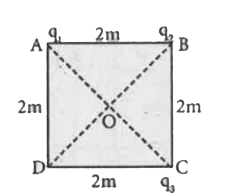ABCD is a square of side 2m. Charges of 5nC,+10nC and −5nC are placed at corners A,B and C respectively .What is the workdone in transferring a charge of 5nC from 'D' to the point of intersection of the diagonals ? Solution in Kannada

In the Fig. .O. represents the point of intersection of the diagonals.
AO=BO=CO=DO=√2
Total electric potential at .O. is
V0=14πε0[q1AO+q2BO+q3CO]
=9×109[5×10−9√2+10×10−9√2−5×10−9√2]
=9×109×10−9[5√2+10√2−5√2]
=9[3.536+7.072-3.536]
V0=63.648 volt
Total electric potential at D is
VD=14π∈0[q1AD+q2BD+q3CD]
=9×109[5×10−92+10×10−92√2−5×10−92]
=9×109×10−9[52+5√2−52]
=9[25+3.536-2.5] = 31.824 volt
∴ Potential difference between O and D is
V=V0−VD=63.648-31.824=31.824 volt
∴ Work required to transfer a charge of 5×10−9 C from D to O is
w=Vq=31.824×5×10−9
w=159.12×10−9 Joule .
Topper's Solved these Questions
- BOOK - SUNSTAR PUBLICATIONCHAPTER - SUPPLEMENTARY EXAM QUESTION PAPER JULY -2015EXERCISE - PART-D11videos
SUPPLEMENTARY EXAM QUESTION PAPER JULY -2015
- BOOK - SUNSTAR PUBLICATIONCHAPTER - SUPPLEMENTARY EXAM QUESTION PAPER JULY - 2014EXERCISE - PART-D (VI. Answer any three of the following questions.)5videos
SUPPLEMENTARY EXAM QUESTION PAPER JULY - 2014
- BOOK - SUNSTAR PUBLICATIONCHAPTER - SUPPLEMENTARY EXAM QUESTION PAPER JUNE-2019EXERCISE - Part-C18videos
SUPPLEMENTARY EXAM QUESTION PAPER JUNE-2019
Similar Questions
Derive an expression for the electric field at a point due to an infinitely long thin charged straight wire using Gauss Law.
06:20View SolutionTwo charges 3x10−8C & −2x10−8C are located 15 cm apart. At what point on the line joining the two charges is the electric potential zero? Take the potential infinity to be 0.
01:38View SolutionMention and five properties of electric field lines.
09:38View SolutionABCD is a square of side 0.2m. Charges of 2×10−9C,4×10−9Cand8×10−9C are placed at the corners A, B and C respectively. Calculate work required to transfer a charge of 2×10−9C from corner D to centre of the square.
02:35View SolutionIn a region where intensity of electric field is 5NC−140 lines of electric force are crossing 10NC−1 will be
02:03View SolutionA charge of 60n C (nanocouloumb) is palced at the corner A of a square ABCD is side 10cm. Another charge of -10nc is located at the centre of the square. Find the work done in carrying a charge of +5 nC from the corner C to the corner B of square.
12:13View Solutioncharges of 20nC each are placed at the corners A and B of a square ABCD of side √8cm and charges of −10nC at the corners C and D. find the potential at the centre of the square.
10:40View SolutionEqual charges q are placed at the three corners B, C, D of a square ABCD of side a. The potential at A is
View SolutionFour point charges +2nC,-3nC,+4nC,-5nC are placed at the vertices A,B,C,D of a square ABCD of side 0.2 m respectively. Calculate the electric field intensity at a point of intersection of the diagonals.
02:54View SolutionThree point charges +10nC,-15nC and +20nC are placed at the corners A,B and C respectively of a square, ABCD of side 0.1m. Calculate the amount of work done to transfer -100nC from the point 'D' to the point 'O'.
02:03View SolutionFour point charges are respectively placed at the corners A, B, C and D of a square of side a. If F is the mid-point of side CD, the work done in carrying an electron of charge from O [the centre of the square] to F fill be:
07:07View SolutionEqual charges q are placed at the three corners B, C, D of a square ABCD of side 'a'. The ratio of potential at A to centre O is
View SolutionCharges 2mC, 4mC and 6mC are placed at the three corners A, B and C respectively of a square ABCD of side x metre. Find, what charge must be placed at the fourth corner so that the total potential at the centre of the square is zero.
07:20View SolutionPoint charges of 10nC,20nCand10nC are kept at the corners A,B C of a square ABCD of side 3m. Calculate the magnitude of the resultant electric intensity at D.
04:26View SolutionAt the corners A,B,C of a square ABCD, charges 10 mC, -20mC are placed. The electric intensity at the centre of the square to become zero, the charge to be placed at the corner D is
View Solution

